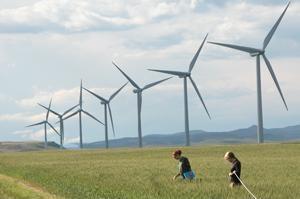Wind turbines are the risk of death of bats
Energy-generating wind turbines have long been thought to be a life-threatening risk for birds. But in fact, a large number of bats have died because of this type of device. The researchers reported in Current Biology, a Cell Press magazine, on August 26 that they found the cause of the situation.
90% of bats examined after death show signs of internal bleeding, along with trauma due to sudden drop in air pressure (a condition called barotraumas) in the turbine wing. Only about half of bats show signs of direct contact with turbine blades. Erin Baerwald of the University of Calgary in Canada said: 'Because bats can identify objects with echolocation, they rarely collide with human-made devices. The sudden drop in air pressure at unrecognizable and unexpected turbine blades is a potential risk for bats, which explains the risk fate of a large number of bats at installations. suffer from this. Bats are more susceptible to barotraumas than birds, and the number of bats killed by wind turbines is much larger than the number of birds killed, so the risk of death from wind turbines is a problem for bats. , not for birds'.
The respiratory system of bats and birds varies at many important points, both in structure and function. Bats' lungs, like the mammalian lungs, are like a balloon, with two-way airflow ending in thin and flexible bags surrounded by capillaries. When the external pressure drops, these bags can inflate too large, causing the capillaries to break. In contrast , the bird's lungs are stronger and more like a tube, with a one-way airflow around the capillaries.
That breathing system makes it easier for them to withstand the sudden drop in air pressure. Most bats that die from wind turbines are migratory bats, sleeping on trees, including white-haired bats, eastern red bats, and silver-haired bats. The number of these bats has not yet been determined, but the researchers said that the death of large numbers of bats could have immeasurable consequences.

Most bats that die because of wind turbines are migratory bats that land on trees, according to Dr. Erin Baerwald, project leader.(Photo: Grady Semmens, University of Calgary).
Bats usually live for many years, in some cases can reach the age of 30 or more. Most of them only give birth to 1 or 2 babies at a time, and not necessarily every year. Robert Barclay, of the University of Calgary, said: 'Slow reproductive speed can limit the ability of species to recover from crises leading to threatened or even extinct species'. He also stressed that migratory animals are often more vulnerable.
All three migratory bats that die from wind turbines feed in the evening, their food being thousands of species of insects - including season pests. Therefore, the number of bats in a reduced area may have an impact on the ecosystem several miles away, during their migration journey.
Baerwald said there is no way to improve the pressure drop in wind turbines without significantly limiting their use. Since bats are often active when the wind speed is low, we can increase the speed of the turbine blades starting to turn towards the end of the bat migration phase.
The research team includes Erin F. Baerwald, Genevieve H. D'Amous, Brandon J. Klug and Robert MR Barclay of Calgary University in Calgary, AB Canada.
Refer:
Erin F. Baerwald, Genevieve H. D'Amours, Brandon J. Klug and Robert MR Barclay.Barotrauma is a significant cause of bat fatalities at wind turbines.Current Biology, 2008;Vol 18, R695-R696 [link]
- Wind turbines are 1.5 times taller than the Eiffel Tower
- Innovative wind turbines in design
- How many wind turbines are needed to meet the electricity demand of the world?
- The first 10 wind turbines in the West Sea
- Principle of operation of wind turbines
- Superconducting tape can help create wind power at a lower cost
- Offshore wind power: Potential in the future
- Exotic style equipment
- Wind fields hinder detection of nuclear weapons testing
- Japan turns the wind into electricity for the country for 50 years
- Wind turbines generate electricity from scrap
- Wind turbines help plants grow better
 Animal 'suffering' after hibernation
Animal 'suffering' after hibernation Why do goats climb well?
Why do goats climb well? Scientists were surprised to see chimpanzees eating turtles
Scientists were surprised to see chimpanzees eating turtles Giant catfish died deadly due to drought in Thailand
Giant catfish died deadly due to drought in Thailand The world's largest mammal migration
The world's largest mammal migration  Bats pretend to be wasps to avoid being eaten by owls
Bats pretend to be wasps to avoid being eaten by owls  The world's most beautiful library uses 'bats' to preserve old books and manuscripts
The world's most beautiful library uses 'bats' to preserve old books and manuscripts  Bats and Enviable Superpowers
Bats and Enviable Superpowers  Specter bats specialize in cannibalism
Specter bats specialize in cannibalism  Devil bats kiss their species in exchange for blood
Devil bats kiss their species in exchange for blood 